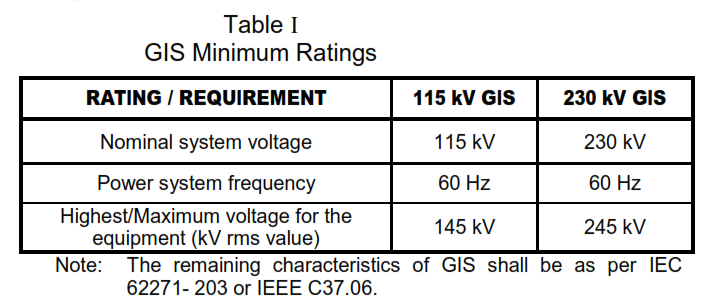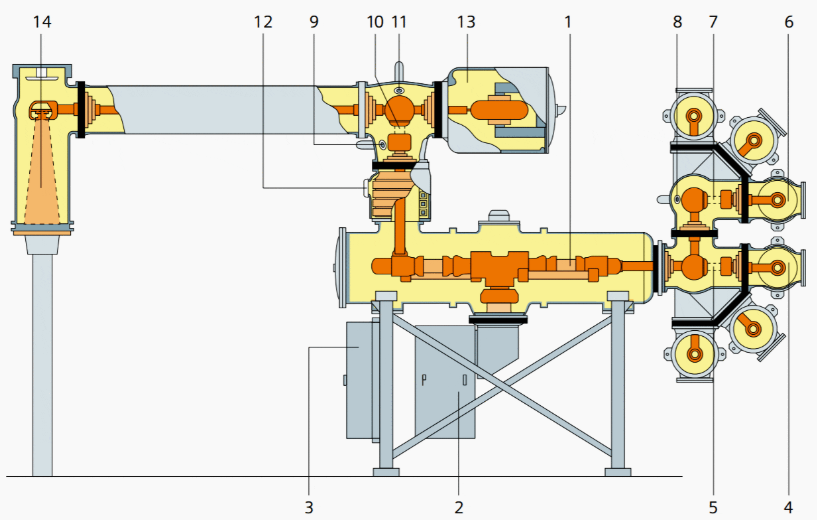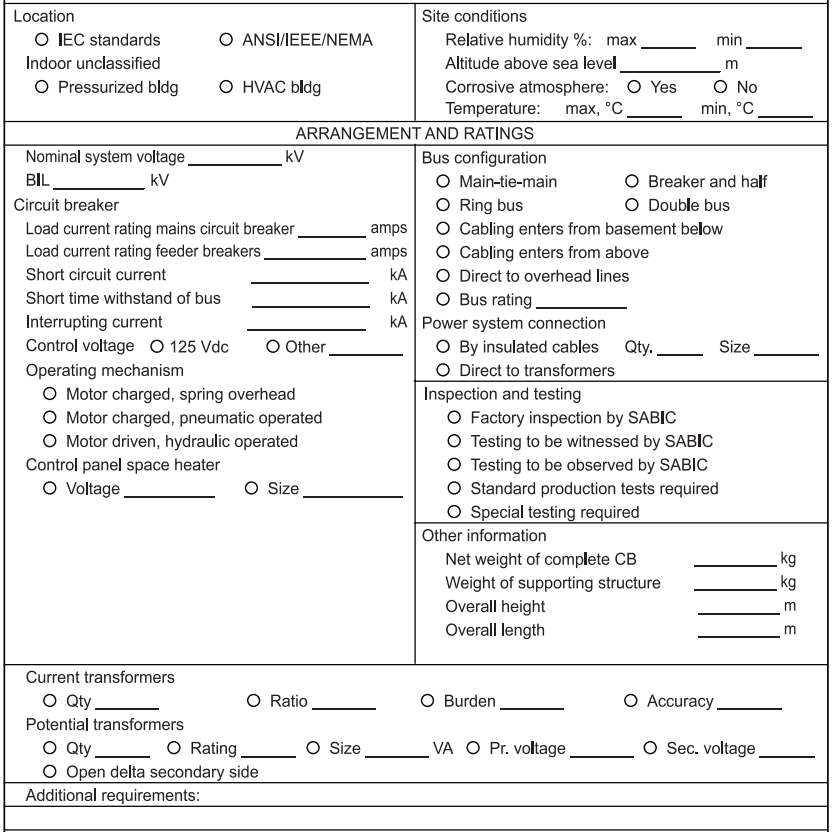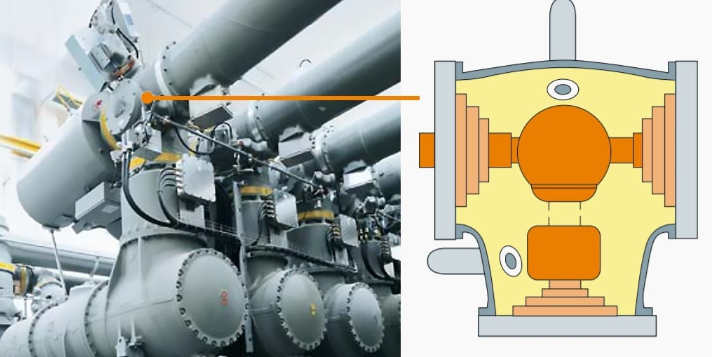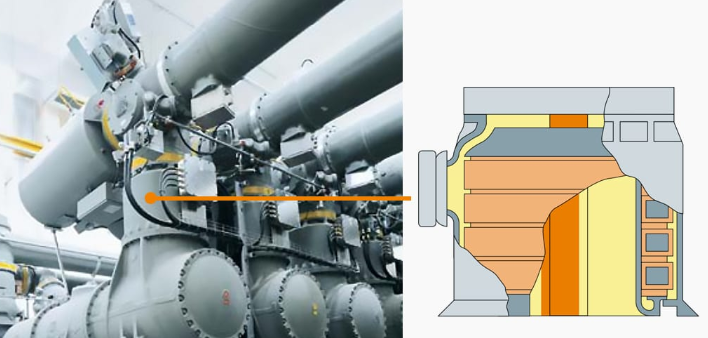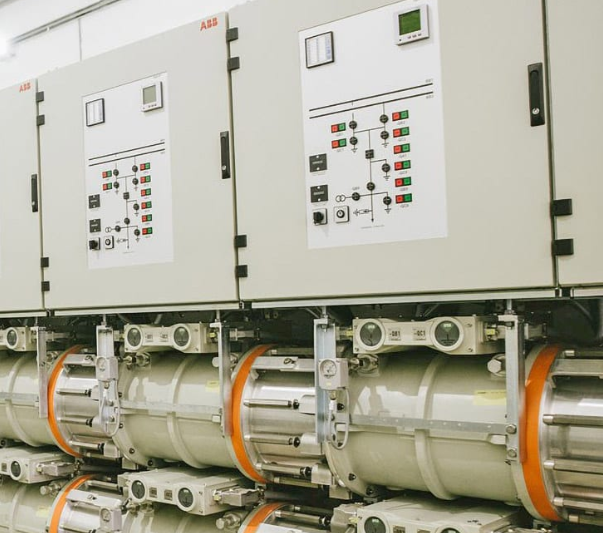This article is about manufacturing, factory testing, field installation and field testing of 115 kV and 230 kV gas insulated switchgear (GIS) to be built in accordance with either American National Standards Institute (ANSI) or International Electrotechnical Commission (IEC) standards. Main keywords for this article are NEC High Voltage Gas Insulated Switchgear Design, GIS Switchgear Gas System, High Voltage GIS Circuit Breakers, High Voltage Gas Insulated Switchgear Test.
High Voltage Gas Insulated Switchgear References
American Society for Testing and Materials (ASTM)
D 2472 Specification for Sulfur Hexafluoride
Institute of Electrical and Electronic Engineers (IEEE)
80 Guide for Safety in AC Substation Grounding
1300 Guide for Cable Connection for Gas-Insulated Substations
C37.04 Standard Rating Structure for AC High Voltage Circuit Breaker Rated on a Symmetrical Current Basis
C37.06 AC High-Voltage Circuit Breaker Rated on a Symmetrical Current Basis – Preferred Ratings and Related Required Capabilities
C37.09 Standard Test Procedure for AC High-Voltage Circuit Breaker Rated on a Symmetrical Current Basis
C57.13 Requirements for Instrument Transformers
C57.13.2 Conformance Test Procedures for Instrument Transformers
International Electrotechnical Commission (IEC)
60038 IEC Standard Voltages
60044-1 Instrument Transformers – Part-1: Current Transformers
60044-1 Instrument Transformers – Part-2: Inductive Voltage Transformers
60376 Specification and Acceptance of New Sulfur Hexafluoride
61936-1 Power installations exceeding 1 kV a.c. – Part 1: Common rules
62271-1 High Voltage Switchgear and Controlgear – Part 1: Common Specifications
62271-102 High Voltage Switchgear and Controlgear – Part 102: Alternating Current Disconnectors and Earthing Switches
62271-203 GIS Metal Enclosed Switchgear for Rated Voltage above 52 kV
62271-209 High Voltage Switchgear and Controlgear, Part 209: Cable Connections for Gas Insulated Metal Enclosed Switchgear for Rated Voltages above 52 kV
NEC High Voltage Gas Insulated Switchgear Design Requirement
The GIS shall be an assembly of metal enclosed modular dead tank, circuit breakers, bus bars, switches and associated equipment for control and protection of the high voltage power supply to the plant. Bus configuration and ratings shall be as shown on one line diagrams.
GIS Ratings
- The minimum ratings of the 115 and 230 kV GIS shall be as shown in Table I conforming to IEC 60038, IEC 62271-203 or IEEE C37.06.
NEC High Voltage Gas Insulated Switchgear
- The assembly shall be of dead tank type, with all components of the switchgear, for example circuit breaker, bus bars, disconnect switches, grounding switches, and instrument transformers, housed in grounded metal enclosures. Enclosures shall completely surround all live parts. Switchgear shall meet or exceed the requirements of IEC 62271-203 or IEEE C37.04.
- Provisions shall be made for the addition of future units with minimum disturbance of the existing pressurized switchgear after installation and energization.
- The components shall be factory coordinated and assembled by one manufacturer, with the buses, interconnections, and other items necessary to make each unit complete. Components and materials shall be of the latest field proven design and shall have been in production for a minimum of five years. Obsolete components or components scheduled for discontinuation shall not be used.
- Components contained within the enclosures and assemblies shall conform to the individual codes and standards applying to them, except where noted otherwise in this specification.
- Live parts shall be supported by high grade, corona-resistant and nonhygroscopic insulators within the enclosures. The enclosures shall be filled with sulfur hexafluoride (SF6) gas.
- Switchgear shall be a modular design consisting of standardized bays. Design shall make efficient use of building floor space.
- Equipment shall be designed to allow for thermal expansion due to operating and short-circuit temperature rise of the bus bars within enclosures, and the enclosures themselves, as required.
- The required base frame and supporting structures shall form part of the equipment. Vendor shall furnish any support rails or channels which are to be connected to or embedded in a concrete floor.
- Adequate openings, space, ladders and platforms shall be provided for easy access during installation, inspection, operation and maintenance.
- Assembly shall be arranged to allow removal of components of a bay without dismantling the adjoining bays.
- Enclosures shall be made from metal (preferably cast aluminum) and shall be permanently bonded in accordance with IEC 61936-1. The enclosure shall withstand an internal arc in accordance with IEC 62271-203. The duration of current without burn-through for different values of the short circuit current shall be asked from the manufacturer based on their calculation procedure. The performance criteria for the duration of the arc according to the performance of the protective system shall be as per IEC 62271-203, Table 104.
- Copper grounding pads shall be provided for grounding the individual enclosures of each module. The grounding pads shall be connected to a common grounding bus mounted as a part of the assembly. A minimum of two (2) external copper lugs shall be provided on each ground bus section to accept a 120 mm2 grounding cable.
- The breakers and switches shall be equipped with position indicators. These indicators shall be positively and solidly connected to the drive shaft. Linkages and levers shall not be acceptable. The disconnect switches shall be provided with viewing windows for visual verification of switch positions.
- Following is single line diagram and operation of GIS Switchgear
GIS Switchgear Gas System
- The insulating and interrupting medium shall be SF6 gas, conforming to IEC 60376 or ASTM D 2472.
- Assembly shall be divided into bays, and each bay into gas-tight and arc- resistant compartments, to confine the effect of any fault to the respective
compartment. Minimum compartmentalization shall be as follows:
a. Bus (and bus isolators) shall have separate compartment in each module b. Circuit breaker compartment, with maintenance earthing switches and current transformers (CTs)
c. Cable termination compartment, with cable isolator and earthing switches - Each gas-filled compartment shall be equipped with static filters. Filters shall be able to absorb any water vapor penetrating the compartment, and decomposition products of SF6 gas. Filters shall have a minimum life expectancy of ten (10) years.
- Assembly gas barriers and joints shall have a high degree of tightness, to keep gas pressure loss to less than 1 percent per year, based on the individual compartments.
- Each major device or section shall be accessible for monitoring and maintenance without evacuating a large volume of gas.
- Each gas filled compartment shall have its own SF6 gas monitoring device and rupture diaphragm which ruptures to discharge gas if it reaches an excessive pressure. Vented gas shall be diverted away from the operating aisle.
- Gas Monitoring:
A. Gas monitoring devices shall be temperature compensated and be of the pressure or density type. The monitoring device shall provide at least two sets of alarm levels for pressure or density (alarm and minimum functional pressure or density). When the rated filling density differs between adjacent compartments, a third alarm indicating over density may be used.
B. Gas monitors shall be provided with one high-pressure contact and three low-pressure contacts, for alarm and interlocking. All contacts for alarm shall be open to alarm. The low gas pressure monitor shall: a. First Stage/(Refill stage): an alarm shall be given and block breaker closing.b. Second Stage: An alarm shall be given in the event of gas density falling below minimum safe operating pressure, limit and block breaker tripping. - Each gas section shall also be provided with a gas connection valve for evacuating and refilling the section. In addition, means shall be provided for connection of a manometer for checking gas pressure. Self-sealing vacuum fittings shall be provided.
- Provisions shall be made so that in the event of a slow pressure loss in one compartment, gas can be connected via the gas supply lines from a gas cart, and pressure can be maintained so as to defer a shutdown until it can be scheduled.
High Voltage GIS Circuit Breakers
- Circuit breakers shall be three-phase or single phase enclosed, SF6 single pressure puffer types described in conforming to IEC 62271-1 or IEEE C37.06.
- Circuit breakers shall have minimum interrupting rating as specified in data sheet, and shall be interchangeable if they are of the same rating. Breakers shall employ a single interrupter per phase.
- Circuit breakers shall be designed to minimize switching overvoltages and shall also be designed for full out-of-phase switching. Breaker design shall eliminate the possibilities of excess transient recovery voltages, and shall be re-strike free.
- Circuit breaker shall have either a spring charge, hydraulic or pneumatic type stored-energy operator. A single operator shall be used to operate all the three phases of the circuit breaker.
- The stored-energy control unit shall be capable of performing a complete open, close-open, close-open operating cycle without recharging (by operation of pump or compressor).
- A loss of electric power to the stored-energy unit shall initiate a local alarm, and shall have a contact to initiate a remote alarm.
- It shall be possible to manually trip the circuit breaker in an emergency when the stored-energy control unit is out of operation.
- Control voltage for close and trip shall be 125 Vdc. Close and trip circuits for each breaker shall be fed from separate circuits and shall be separately protected for over-current.
- Each circuit breaker shall have two tripping coils. A trip coil monitor shall be provided to alarm for failure of either coil, or loss of dc trip power.
- Each circuit breaker shall have a mechanical position indicator linked into the main contact.
- Each circuit breaker shall be supplied with a local control panel (LCP). LCP shall be located at either front of the respective GIS bay in case of indoor installation or on the breaker skid in case of outdoor installation. The control panel shall contain equipment for monitoring, control and maintenance of the circuit breaker and its associated equipment.
- The circuit breaker shall be capable of carrying the rated current, and interrupting and withstanding the short-circuit currents specified in Table I .
- The circuit breaker shall also be capable of interrupting the rated load current in the event of total loss of SF6 gas pressure.
- Provision shall be made to enable the control circuit to prevent fault tripping or closing of the breaker when the SF6 gas pressure within the breaker has dropped below a minimum permissible level.
- Breakers shall have anti-pumping provisions to prevent repeated closures while the closing circuit remains energized, should the circuit breaker either fail to latch, or be tripped during closing due to the operation of the protective relays.
- Four (4) normally open (NO) and four (4) normally closed (NC) spare auxiliary contacts shall be provided in each circuit breaker module and wired out to terminal blocks for use.
- ‘Kirk Key’ interlock system shall be provided for the designated circuit breaker circuits as shown on the referenced single line diagram(s) or SES E08-X03. The interlock system shall be mechanically and electrically interlocked with the breaker to make it inoperative with key(s) removed.
- A mechanical circuit breaker operation counter shall be provided.
- Each circuit breaker shall be provided with 125 Vdc rated auxiliary relays for remote close and open. Control power to remote control auxiliary relays shall be separately protected.
- Provisions shall be included to enable timing test after filling the breakers with SF6 gas.
High Voltage GIS Disconnect and Grounding Switches
- Disconnect switches having the same continuous and withstand current ratings as the associated breakers shall be provided on each side of each breaker, to allow isolation of each breaker for maintenance. Grounding switches shall be provided on each side of each circuit breaker. Switches shall conform to IEC 62271-102.
- Isolation disconnect switches shall be provided for each feeder cable. A grounding switch shall be provided for grounding the feeder cable. Additional disconnect and grounding switches shall be provided as necessary to facilitate work on bus sections and other equipment.
- All switches shall be motor operated. A single operator shall operate the three poles of the switch simultaneously. A 125 Vdc motor shall power the operator.
- It shall be possible to manually operate the switches in an emergency.
- Each switch shall have a mechanical position indicator linked with the main contacts and the viewing windows in the enclosure, to see the actual position.
- Provision shall be provided for padlocking the switches in both open and closed positions.
- Following Location of disconnect switch in GIS Switchgear
- Each switch shall be provided with eight auxiliary contacts (four normally open and four normally closed) in addition to those required for the control scheme.
- The auxiliary contacts of the switches shall be wired out to accessible terminal blocks in the local control panel.
- Disconnect switches shall normally operate at zero current, but they shall be capable of switching the low charging currents, if any.
- The grounding switches on the bus bars (the incoming and outgoing terminals of the switchgear) shall be of the high-speed type. High-speed switches shall be operated by motor charged springs. Grounding switches shall have a fault making capability of 100 kA peak current.
- When high speed switches operate, the contact rod shall be actuated directly to release the springs.
- The disconnect switches shall be interlocked with associated circuit breakers and grounding switches to prevent any incorrect sequence of operation.
https://youtu.be/CQHeEu8oauE
High Voltage GIS Bus System
- Bus bars shall be either Copper or Aluminum with silver, nickel or tin plating at connections. However temperature rise shall not exceed the specified temperatures according to IEC 62271-1, Table-3.
- The bus bar system shall be constructed of modular sub-assemblies whose length corresponds to the bay spacing of the switchgear.
- Gas barriers to form separate gas-tight compartments shall segregate the bus sub-assemblies from each other.
- Expansion joints shall be provided, to compensate for thermal expansion.
- The bus and bus supports shall be designed and braced to withstand the momentary and short-time (3 s) current ratings of the highest rated breaker in the switchgear.
- The bus modules shall be fitted with mechanical means to allow compensation for small variations in the floor level.
https://youtu.be/a2tAcKjdb_0
GIS Instrument Transformers
Current Transformers (CT’s)
a. CT’s shall be rated to withstand the steady state current, and maximum short circuit momentary rating of the switchgear.
b. Accuracy classes and burdens shall be in accordance with IEC 600441 or IEEE C57.13. CT’s shall be suitable for their intended service within the measuring and protective systems of the GIS.
c. CT’s shall be Multi-ratio, bushing type, to be accommodated at least four for each phase, required for metering and relaying.
d. The secondary winding ends and tappings of each bay shall be brought out through gas-tight bushings to terminals in the respective local control cabinet. These terminals shall be of the disconnectable shorting link type.
e. The number of CT’s and ratios shall be shown on the one-line diagrams and SES E08-X03. However, final determination of the metering CT’s ratios shall be done in consultation with the utility company. CT’s shall be selected to not saturate f or a fault current equal to the switchgear maximum short circuit rating.
Following is location of current transformer in GIS Switchgear.
Potential Transformers (PT’s)
a. PT’s shall be of metal-enclosed, gas-insulated inductive, three-phase type, mounted directly on the high-voltage enclosure with plug-in contacts.
b. PT’s shall have a BIL equal to or greater than the BIL rating of the switchgear, and shall have primary voltage rating equal to the system’s line-to-line voltage.
c. Each PT shall have a 120 V secondary winding protected by manual circuit breakers (MCB’s). The MCB’s shall be located to permit safe replacement while the switchgear is energized.
d. PT’s shall be sized by the vendor to accommodate the loads in the switchgear and protection panel, plus any additional loads shown in data sheet. The minimum rating shall be 400 VA. e. Accuracy classes and burdens shall be in accordance with IEC 600442 or IEEE 1300 for voltage transformers. f. All secondary-winding ends shall be brought out through gas-tight bushings to terminals in a terminal box mounted on the outside of the voltage transformer module.
https://www.youtube.com/watch?v=2HwbmfxhZ7Q
High Voltage Gas Insulated Switchgear Control Panel
- Each bay of the assembly shall be provided with a control panel.
- Panels shall be totally metal-enclosed, dead front, freestanding steel structures, and shall be completely factory assembled, wired and tested.
- The control cubicles shall be reinforced to prevent buckling or distortion during transport, erection and operation.
- A 6 x 50 mm copper ground bus shall be provided throughout the length of the panel assembly. The ground bus shall have on each of its ends, one solderless cable lug suitable for a stranded copper grounding cable of size from 50 to 150 mm2.
- Control panel shall contain a microprocessor based unit, which shall include a mimic diagram and an alpha numeric display. Functional features of the local control panel shall be as follows:
a. Operating Functions:
(i) Control panel shall be capable of opening the circuit breaker
(ii) Control panel shall be capable of opening and closing the disconnect and grounding switches
b. Interlocking. The breaker control close function shall be active only when the disconnect switches on both sides of the breaker are in the open position.
c. Monitoring / Diagnostic:
(i) Control panel shall have circuit breaker, grounding switch and disconnect switch position indicators
(ii) Control panel shall have alarm indication for circuit breaker, SF6 and micro pump
(iii) Control panel shall be capable of monitoring SF6 pressure
(iv) Control panel shall contain operation counters for circuit breakers, disconnect switches and ground switches
(v) Control panel shall be capable of monitoring operation time for circuit breakers, disconnect switches and ground switches with alarms for any abnormal values of these operating times
(vi) Control panel shall provide start duration, starts per hour and total operating time for the micro pump
(vii) Control panel shall provide alarms for circuit breaker maintenance based on cumulative breaking currents - Panel face shall contain all gages, counters, mimic bus of the assembly, status indication and control switches for circuit breaker, disconnect and grounding switches and other components specified on the assembly drawings.
- A diagram shall be located on the inside of the panel door to show the relationship of valves, gages and other components in the SF6 gas systems.
- The wiring between the switchgear and the remote control panel shall be wired through the local control panel.
- The interconnection of wires between the switchgear assembly and the local control panel shall be by means of pre-assembled cords with multi-pin connectors.
- Provision shall be made for cable or conduit entry into the panel of external connections.
High Voltage Gas Insulated Switchgear Test and Inspection
- Need to describe procedures of the tests which shall be carried out at the factory and the site after erection. All standard production tests defined in IEC 62271-203, and the tests listed in this specification shall be included. Sufficient testing shall be done in the factory to fully prove the equipment. Site testing shall be adequate to detect any damage in transit or storage, and to prove the field installation work.
- As a minimum, factory testing shall include the following:
a. Prior to module assembly, the individual enclosures of each module shall be:
(i) Pressure tested with water to twice the design pressure
(ii) Evacuated, placed in a helium environment and then checked for leakage of helium in to the enclosure. No leakage shall be allowed.
b. Once the modules have been completed, the assembly shall be tested filled with SF6 to its operating pressure and checked for gas leakage using an SF6 gas detector. No leakage shall be allowed.
c. The components of the GIS assembly shall be tested to the relevant standards
d. Circuit breakers shall be tested for power frequency voltage withstand, contact resistance, mechanical operation at minimum control voltage, verification of stored energy operating cycle and measurement of operating time. Testing ofHV circuit breaker shall be in accordance with IEC 62271-1 or IEEE C37.09. e. Switches shall be tested for power frequency voltage withstand, contactresistance and mechanical operation (70 cycles total at minimum, rated and maximum supply voltage)
f. Instrument transformers shall be tested for terminal markings, polarity and ratio, power frequency withstand test on secondary windings, power frequency withstand test on primary windings, and measurement of partial discharges. Tests shall include determination of CT excitation curve and determination of PT output voltage errors versus load. Testing of CT’s and PT’s shall be in accordance with IEC 60044-1 and 60044-2 respectively, or IEEE C57.13.2.
g. Shipping sections shall have all gas compartments filled with SF6, and be fully tested prior to shipment
h. Circuit breakers and local panels shall be completely assembled and all interconnecting wiring shall be installed. After complete assembly and all temporary interconnecting wiring is complete, the switchgear shall be completely functionally tested, demonstrating all control, trip, interlocking, indications, and proper functioning of all meters. The functions shall be verified through primary current and secondary voltage injection.
Testing shall include the following:
a. High voltage test for main circuits
b. High voltage test for auxiliary and control circuits
c. Verification of the resistance of the main circuits
d. Fluid leakage tests
e. Measurement of moisture in SF6
f. Complete functional testing of all components including mechanical operation, controls, interlocks, protective relays, indicating lights and safety devices g. Complete functional testing by primary current injection and secondary voltage injection verifying all controls, logic, trip, inhibit, interlocking, protective relaying and metering. Primary injected current may be a minimal value of less than 100 A. Protective relay settings shall be set at minimal values to ensure relays pick up and trip at the low amounts of current. Upon completion of functional testing, the final protective relay settings shall be installed. h. Verification of absence of dangerous circulating currents in the enclosures and other metal parts, if these are not intended for such currents .
NEC High Voltage Gas Insulated Switchgear Design, GIS Switchgear Gas System, High Voltage GIS Circuit Breakers, High Voltage Gas Insulated Switchgear Test.
